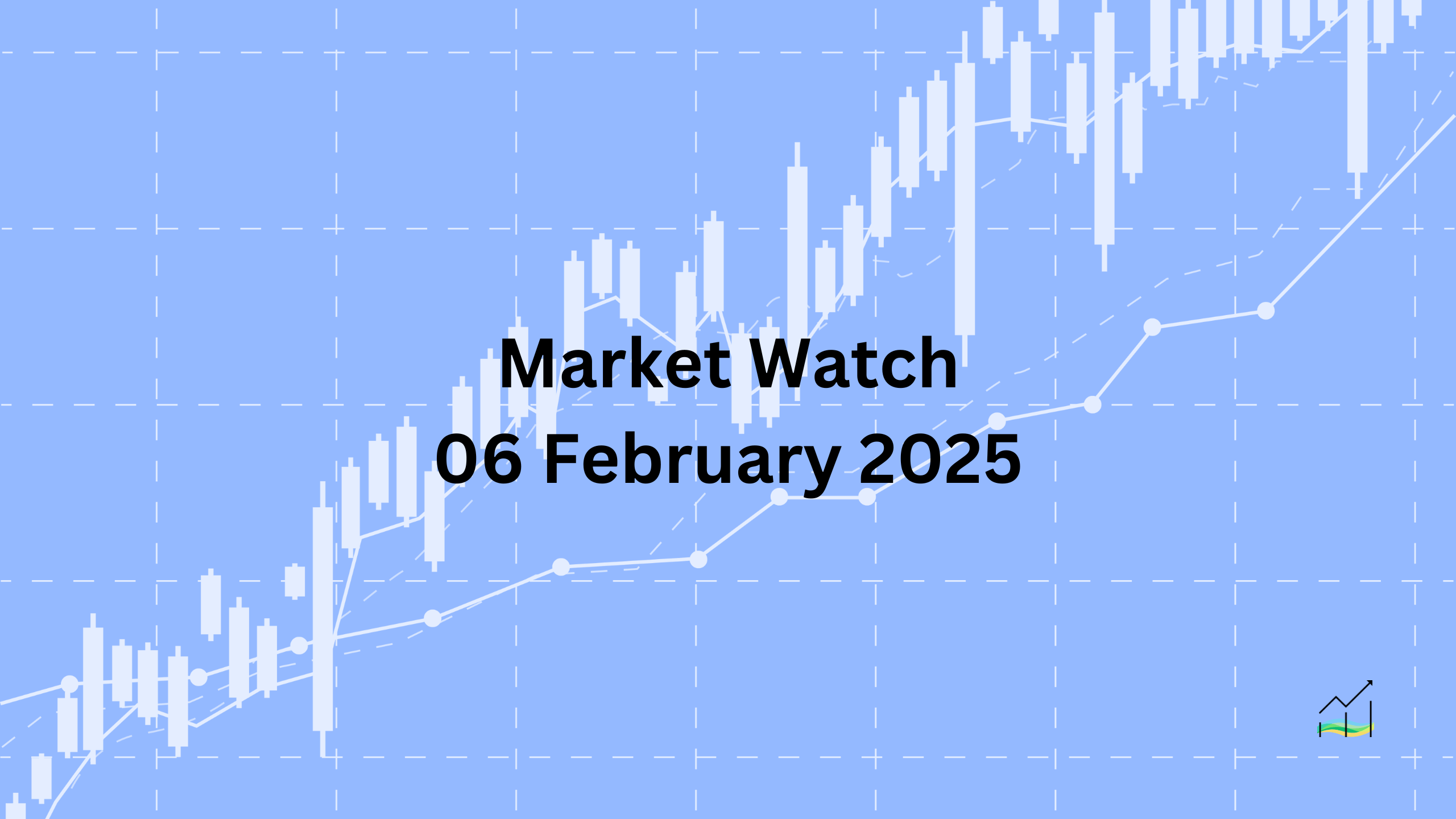06/02/2025 Market Watch

Dollar Firms Ahead of U.S. Jobs Data
After a brief pullback following Monday’s tariff-driven surge, the US dollar has regained strength, likely due to position adjustments ahead of the upcoming US employment report. Some Federal Reserve officials have acknowledged that tariffs could create supply-side pressures, yet market expectations for a June rate cut and two cuts by year-end have slightly increased. Despite lower Treasury yields, the dollar remains under pressure against most G10 currencies, though it is steady against the Japanese yen. Meanwhile, the British pound is the weakest among major currencies, declining by about 0.6% as markets anticipate a Bank of England rate cut. Emerging market currencies are also softer, with the Mexican peso under pressure ahead of a potential 50-basis-point rate cut by the country’s central bank.
In equities, markets are broadly positive. Asian stocks, particularly in China and Hong Kong, led gains. European equities, measured by the Stoxx 600, are up about 0.8%, marking their largest gain in three weeks if sustained. US stock futures are slightly higher. Bond yields remain stable across Europe, with the UK 10-year Gilt yield down 1.5 basis points—the largest decline in the region. The US 10-year Treasury yield, which hit its lowest level since mid-December at 4.40%, has edged up to around 4.44%.
Gold is consolidating after reaching a record high above $2,882, while oil prices remain firm. March WTI crude is holding within Wednesday’s range of $71-$73 per barrel, which itself was contained within Tuesday’s broader range of $70.70-$73.35. The firmer dollar and rising yields suggest a period of consolidation across key markets ahead of the US labor data release.
United States of America
Overview
The Dollar Index has rebounded after hitting its lowest level since late January, when markets expected a tariff delay. Earlier this week, the index spiked near 109.90 on fears of tariff implementation but quickly reversed after the postponement. Despite this retreat, the dollar has regained support today as investors reposition ahead of the US employment report.
Economic Drivers
US interest rates are firmer, supporting the dollar’s rebound. While today's Q4 productivity and unit labor costs provide insight into economic conditions, they have limited immediate market impact. These metrics are derived from GDP data and suggest that unit labor costs likely rose due to weaker productivity. Meanwhile, job cuts and weekly unemployment claims are taking a backseat to Friday’s broader labor market report, which includes annual benchmark revisions to payroll data.
Data and Events
Key US labor data is in focus, with tomorrow’s employment report being the primary driver of market sentiment. Investors are closely watching how revised job figures may influence expectations for Federal Reserve policy.
Price Action
The Dollar Index has edged back above yesterday’s high and may test the 108.25–108.50 range ahead of the jobs data.
Key Points:
- Dollar index rebounded after dropping to its lowest since January 27.
- Tariff impact spiked near 109.90 earlier this week but retreated after postponement.
- US rates firming, providing support for the dollar.
- Weekly claims and job cuts overshadowed by Friday’s key labor data.
- Dollar Index could test 108.25–108.50 before US employment report.
Australia
Overview
The Australian dollar has pulled back after testing the $0.6300 level, retreating to around $0.6255. Earlier in the week, it dipped slightly below $0.6090 but rebounded strongly. However, momentum has stalled, and the 20-day moving average at $0.6240 could act as support.
Economic Drivers
Expectations for a rate cut remain a key factor influencing the Australian dollar. The futures market is fully pricing in a 25-basis-point cut on February 18, marking the start of an easing cycle. A recent survey of 25 economists shows that 23 expect a rate reduction, aligning closely with market expectations.
Data and Events
Australia released its December trade data today, but it had little immediate market impact. The trade surplus was smaller than anticipated, driven by weaker exports and stronger imports.
Price Action
The Australian dollar failed to hold gains near $0.6300 and has pulled back. If selling pressure continues, support at $0.6240 (the 20-day moving average) will be closely watched.
Key Points:
- Australian dollar pulled back after testing $0.6300, now near $0.6255.
- December trade surplus was smaller than expected due to weaker exports and stronger imports.
- Markets and economists strongly anticipate a 25-bp rate cut on February 18.
- The 20-day moving average at $0.6240 may act as support.
Canada
Overview
The Canadian dollar has regained ground after its sharp sell-off earlier in the week when US tariffs seemed inevitable. This rebound overshadowed weaker-than-expected trade data and soft PMI figures. The US dollar dropped to CAD1.4270, its lowest since last month, before settling near CAD1.4310. Today, it has regained some strength, reaching above CAD1.4365, with potential resistance near CAD1.4400.
Economic Drivers
Canada’s trade surplus for December came in at C$0.7 billion, lower than the expected C$1.02 billion, while November’s deficit was revised higher. The composite PMI remained below the growth threshold for the second straight month, signaling ongoing economic softness. Interest rate differentials stabilized, supporting the Canadian dollar’s recovery.
Data and Events
Markets are focused on Canada’s upcoming jobs report, expected to show a sharp slowdown in employment growth from December’s strong 90.9k increase. The unemployment rate is also projected to edge higher, adding to economic concerns. While the IVEY PMI is due today, it is unlikely to significantly impact market sentiment.
Price Action
The US dollar’s drop to CAD1.4270 marked a key technical level, meeting the 38.2% retracement of its rally from September’s low. Today’s recovery above CAD1.4365 suggests buyers are returning, with resistance likely near CAD1.4400.
Key Points:
- Canadian dollar rebounded sharply after initial weakness due to US tariff concerns.
- Canada’s December trade surplus was smaller than expected, and November’s deficit was revised higher.
- Composite PMI remained below the expansion threshold for the second consecutive month.
- US dollar fell to CAD1.4270 before recovering above CAD1.4365, with resistance near CAD1.4400.
- Markets are focused on Canada’s jobs report, which is expected to show weaker employment growth and a higher unemployment rate.
China
Overview
The US dollar has pulled back from its peak earlier in the week against the offshore yuan, falling from CNH7.3735 on Monday to slightly below CNH7.27 yesterday. Today, it is consolidating, hovering near CNH7.30, where the five and 20-day moving averages converge. Despite recent tariff developments, the People's Bank of China (PBOC) has not shifted its approach and is not using currency depreciation to counter the impact.
Economic Drivers
Even with the 10% US tariff and China’s retaliatory measures, the PBOC remains committed to currency stability. The central bank has kept its dollar reference rate nearly unchanged since before the Lunar New Year holiday, reinforcing its stance on not allowing excessive yuan depreciation.
Data and Events
The PBOC’s recent reference rate fixes show minimal adjustments, with yesterday’s fix at CNY7.1693 and today’s at CNY7.1691. The yuan continues to trade within its permitted 2% range around the reference rate, reflecting controlled market conditions.
Price Action
The US dollar’s decline against the yuan is pausing near CNH7.30, where key moving averages align. If upward momentum continues, this level may act as a short-term resistance, while a break below CNH7.27 could signal further downside.
Key Points:
- US dollar pulled back from its Monday peak of CNH7.3735 to below CNH7.27 before stabilizing.
- PBOC is maintaining a stable reference rate, showing no signs of using depreciation as a policy tool.
- Yuan’s reference rate remains nearly unchanged from pre-Lunar New Year levels.
- US dollar is consolidating around CNH7.30, where key moving averages converge.
- A break above CNH7.30 could lead to further gains, while a move below CNH7.27 may indicate more weakness.
Europe
Overview
The euro regained ground lost during the US tariff-driven sell-off, briefly rising above last Friday’s high of $1.0440 after bouncing from Monday’s low near $1.0140. However, ahead of the US employment report, caution has returned, and the euro has pulled back to around $1.0355.
Economic Drivers
Market expectations indicate that the European Central Bank (ECB) is likely to cut rates by at least 50 basis points before the Federal Reserve makes another move. This expectation has contributed to the euro’s recent movements, as traders position for potential monetary policy shifts.
Data and Events
The euro weakened following disappointing December retail sales data, which fell by 0.2% against a median forecast of a 0.1% decline. Additionally, November’s 0.1% gain was revised down to flat, adding to concerns about weak consumer spending.
Price Action
The euro is now retreating from its recent gains, testing support in the $1.0300-$1.0325 range. A break below this level could signal further downside, while resistance remains near $1.0440.
Key Points:
- Euro rebounded from Monday’s low of $1.0140 to briefly surpass $1.0440.
- Caution has returned ahead of the US employment report, pushing the euro lower.
- ECB is expected to cut rates by at least 50 basis points before the Fed acts again.
- December retail sales declined by 0.2%, weaker than expected, with November’s gain revised to flat.
- Euro is testing support around $1.0300-$1.0325, with resistance near $1.0440.
Japan
Overview
The dollar weakened against the yen, settling below its 200-day moving average for the first time since mid-December. A low near JPY152.10 was set yesterday, followed by further declines to JPY151.80 today, driven by falling US rates, broad dollar weakness, and stronger Japanese wage data. However, a recovery in US yields and general dollar strength helped the greenback bounce back toward JPY153 in early European trading, where selling pressure emerged.
Economic Drivers
Hawkish comments from the Bank of Japan (BOJ) contributed to the yen’s strength, reinforcing expectations of a policy shift. Meanwhile, US 10-year yields dipped to their lowest level since December 18, briefly touching 4.40% before rebounding to around 4.44%.
Data and Events
Japan will release December household spending data tomorrow, which is expected to show a 0.5% year-over-year increase—the first gain since July 2023 and the first positive December reading since 2018. In contrast, December 2023 saw a 2.5% decline from the previous year.
Price Action
The dollar’s decline pushed it to JPY151.80 before rebounding toward JPY153, with resistance seen at this level. The lower band is near JPY152.70, acting as a potential technical barrier.
Key Points:
- Dollar settled below its 200-day moving average against the yen, hitting a low near JPY152.10.
- Hawkish BOJ comments and strong Japanese wage data pressured the dollar to JPY151.80.
- A rebound in US rates and broader dollar recovery pushed the pair back toward JPY153.
- US 10-year yield briefly dipped to 4.40% before rising to 4.44%.
- Japan’s household spending is expected to post a 0.5% year-over-year gain, marking the first December increase since 2018.
United Kingdom
Overview
The market is highly confident that the Bank of England (BoE) will cut interest rates by 25 basis points today, with expectations that the easing cycle will continue. While a dissent is possible, recent data supports the case for a rate cut.
Economic Drivers
Despite persistent wage growth above 5%, rising service prices, and cost pressures from higher national insurance and minimum wage hikes effective April 1, the majority view within the BoE leans toward easing. The latest construction PMI fell sharply to 48.1 from 53.3, marking its first sub-50 reading since February 2023, reinforcing expectations of weaker economic momentum.
Data and Events
The swaps market has nearly fully priced in the next rate cut for the May 8 meeting, aligning with local elections scheduled for May 1. Yesterday’s final PMI reading revealed the fastest increase in service prices in 13 months, with a quarter of firms raising prices and more than a third facing higher costs.
Price Action
Sterling climbed to $1.2550 yesterday, its highest level since January 7, before pulling back. The rally met the 61.8% retracement of losses since the December 6 high, when sterling last traded above $1.28. Today, it tested support in the $1.2380-$1.2400 zone, with option-related sales likely adding pressure. Notable options expiring today include $1.2455 (~GBP1.4 billion) and $1.2550 (GBP1.0 billion).
Key Points:
- BoE is expected to cut rates by 25 basis points, with market confidence in further easing.
- Service prices rose at the fastest pace in 13 months, and wage growth remains above 5%.
- Construction PMI dropped to 48.1, signaling contraction for the first time since February 2023.
- Swaps market has nearly fully priced in the next rate cut for May 8.
- Sterling hit $1.2550 yesterday but pulled back, testing support near $1.2380-$1.2400.
- Large options expirations at $1.2455 and $1.2550 may have influenced price action.
© 2025 SKONE Enterprise (003319453-V). All rights reserved.
The content on this site is for informational purposes only and does not constitute financial advice.


